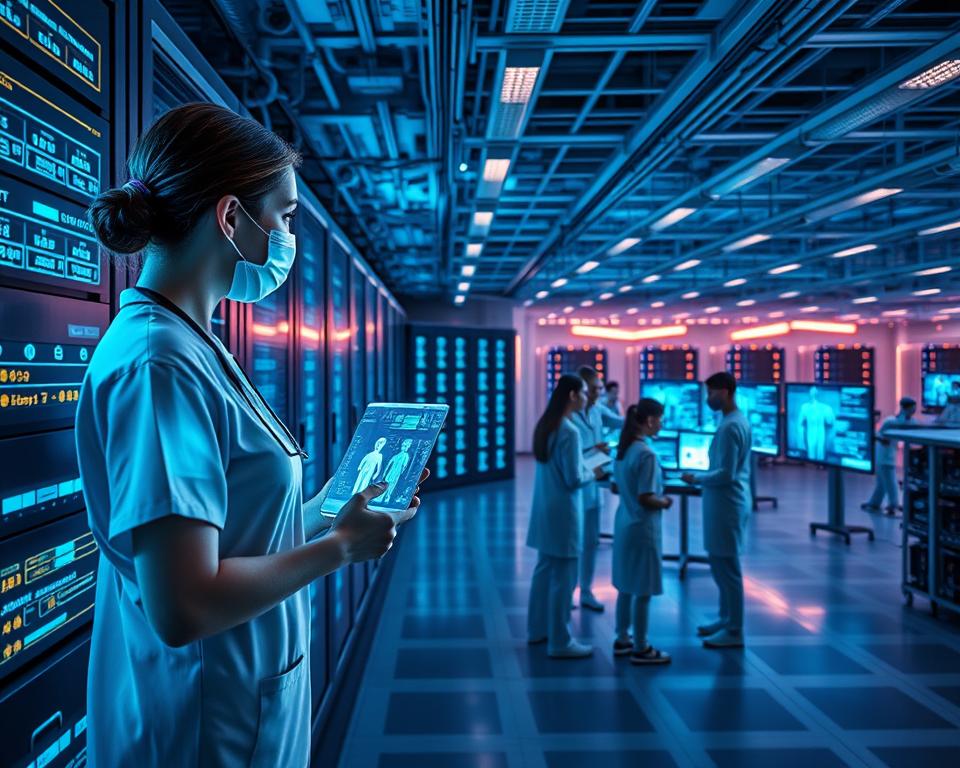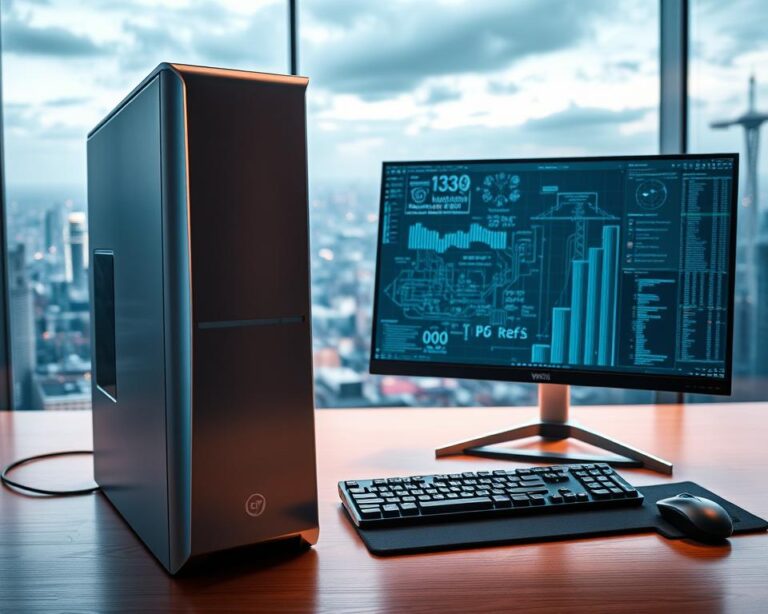
Nursing Informatics and Tech: Streamline Information Management
Did you know that over 80% of nurses believe that using nursing informatics and technology information management systems significantly enhances patient care? In today’s rapidly evolving healthcare landscape, the integration of technology is not just a trend—it’s a necessity. Nursing informatics stands at the intersection of nursing and technology, focusing on the efficient management of information to improve healthcare delivery. By streamlining information management, healthcare providers can ensure that patient care is more effective, efficient, and outcomes-driven. With advanced healthcare technology, nursing professionals are transforming traditional practices, marking a pivotal shift in the way they operate and deliver care.

Key Takeaways
- Nursing informatics combines nursing and technology for better patient outcomes.
- Technology improves the efficiency of information management in healthcare settings.
- Healthcare technology is essential for modern nursing practices.
- Streamlining information management supports clinical decisions.
- The rise of digital health solutions is transforming nursing roles.
Introduction to Nursing Informatics
Nursing informatics has gained significant traction in recent years as a vital aspect of healthcare innovation. It serves as a bridge between nursing science and information technology, focusing on the effective management and processing of healthcare data. By employing specialized tools and methodologies, nursing informatics aims to enhance patient care outcomes and streamline clinical operations.
The origins of nursing informatics can be traced back to the growing need for efficient communication and data management within healthcare settings. As technology has rapidly evolved, so too has the role of nursing informatics professionals. They are now more integral to developing systems that ensure accurate and timely information flow, which is essential for patient safety and quality of care.

Implementing nursing informatics fosters collaboration among interdisciplinary teams, enabling healthcare providers to make informed decisions based on real-time data. The integration of various informatics tools ensures that patient information is readily accessible while maintaining privacy and security. This improves overall efficiency in healthcare systems and contributes to a higher standard of care for patients.
The Role of Technology in Healthcare
Technology serves as a vital component in the landscape of modern healthcare delivery. With innovations like telehealth, electronic health records (EHR), and clinical decision support systems, healthcare technology streamlines processes and enhances communication among professionals. These technological advancements in nursing contribute significantly to accessibility and efficiency in patient management.
Telehealth has expanded access to care, allowing patients to consult healthcare providers remotely. This shift ensures that individuals in rural or underserved areas receive timely medical attention. In addition, the integration of electronic health records simplifies data collection and patient monitoring, ensuring that healthcare professionals have immediate access to vital information.

The implementation of clinical decision support systems fosters improved health outcomes through evidence-based recommendations, aiding professionals in making informed choices. These systems promote a data-driven approach, enhancing operational efficiency and ensuring that patient care remains a priority.
| Technology Component | Impact on Healthcare |
|---|---|
| Telehealth | Increases accessibility and reduces travel time for patients |
| Electronic Health Records | Enhances patient data management and information sharing |
| Clinical Decision Support Systems | Improves decision-making with evidence-based guidelines |
As technology continues to evolve, the role of technological advancements in nursing will undeniably shape the future of healthcare, fostering an environment where quality patient care is paramount.
Nursing Informatics and Technology Information Management Systems
Nursing informatics plays a critical role in the healthcare landscape by integrating technology into information management systems. These systems are designed to streamline the collection, storage, and retrieval of clinical data, which enhances nursing practice significantly. Understanding how these information management systems function within nursing can lead to improved patient care and operational efficiencies.
Understanding Information Management in Nursing
Information management in nursing revolves around the effective use of nursing informatics tools. These tools aid in organizing data related to patient assessments, treatments, and outcomes. Key aspects of information management include:
- Data entry: Nurses input patient data into electronic systems, which reduces the risk of human error.
- Storage: Secure systems store patient records indefinitely, making it easier to access historical data.
- Retrieval: Quick access to information allows for timely decision-making in patient care.
- Sharing: Information management systems enable seamless sharing of data across various healthcare settings.
Key Benefits of These Systems
The advantages of utilizing robust information management systems are manifold. Outcomes can significantly improve as a result of the following benefits:
- Enhanced accuracy: Digital records minimize errors compared to paper-based documentation.
- Reduced paperwork: Streamlined processes lessen the administrative burden on nursing staff.
- Quicker access: Fast retrieval of information supports prompt clinical interventions.
- Improved patient engagement: Patients can participate in their care through access to electronic records and communication tools.

| Benefit | Description |
|---|---|
| Accuracy | Reduces errors in patient data documentation |
| Efficiency | Streamlines workflow processes, saving time for nurses |
| Accessibility | Allows immediate access to patient information across platforms |
| Engagement | Encourages patient participation through shared information |
Electronic Health Records: A Game Changer
Electronic health records (EHRs) play a pivotal role in transforming how patient information is managed within the healthcare system. By digitizing patient data, EHRs enhance the overall efficiency of healthcare services and improve patient outcomes. Understanding the importance of EHRs and recognizing the EHR benefits and challenges are essential for healthcare professionals navigating this technology.
Importance of EHRs in Patient Care
EHRs facilitate better communication among healthcare providers, leading to improved coordinated care. With real-time access to critical health information, practitioners can make informed decisions to enhance patient safety. This comprehensive digital format allows for a streamlined flow of information, ensuring that every team member involved in patient care is on the same page.
Challenges in EHR Adoption
Despite the numerous advantages, there are notable challenges associated with the adoption of electronic health records. High implementation costs can be a significant barrier for many healthcare facilities. Data security concerns also loom large, given the sensitive nature of health information. Additionally, ensuring that healthcare staff receive proper training remains crucial for maximizing the potential of EHRs.

Data Analytics in Healthcare
Data analytics in healthcare plays a crucial role in modern medical practices. By utilizing this technology, healthcare professionals can sift through extensive patient records to uncover patterns and insights. This process significantly enhances healthcare data interpretation, allowing for more informed decision-making.
Healthcare analytics enables nursing professionals to identify trends in patient populations. It aids in predicting outcomes based on historical data, thus personalizing patient care. For example, analytics can help determine which treatments may offer the best results for specific demographics, thereby improving overall health outcomes.
Additionally, the efficient use of data analytics in healthcare leads to operational improvements. Hospitals and clinics can streamline processes and resource allocation, which ensures that staff focus on what matters most—patient care. As technology continues to advance, the integration of data analytics into healthcare will likely expand, further enriching the field.
Informatics in Nursing Education
The integration of informatics into nursing education has become crucial for developing well-rounded healthcare professionals. Nursing curricula development now emphasizes the importance of technology in enhancing patient care and administrative efficiency. This shift not only prepares students for today’s healthcare landscape but also equips them with essential skills for the future.
Integrating Technology into Nursing Curricula
Many nursing programs have started incorporating technology through various approaches. Simulations provide realistic learning experiences, allowing students to practice their skills in a safe environment. Case studies based on real-life scenarios help learners understand complex situations they may encounter in practice. Practical training with real-time data systems ensures that future nurses are familiar with the tools they will use in their careers.
Future Skills Needed for Nurses
To meet the demands of modern healthcare, future nurses must master specific skills. Proficiency in data management is essential for understanding patient information and clinical outcomes. Familiarity with telehealth practices becomes increasingly important as remote care options expand. Knowledge of relevant software applications will enable nurses to navigate technology effectively, ensuring they provide the best possible care.
Telehealth Technology: Expanding Access to Care
Telehealth technology has revolutionized healthcare delivery by enabling remote patient care that transcends geographical barriers. Patients can now participate in consultations, receive follow-ups, and manage chronic conditions from the comfort of their homes. With secure platforms like Zoom for Healthcare and Doxy.me, healthcare providers can interact seamlessly with patients, enhancing the overall quality of care.
This innovative approach not only improves accessibility for patients in rural or underserved areas but also minimizes the need for travel, saving both time and resources. The increase in telehealth services during public health emergencies has further highlighted its significance in maintaining continuity of care.
Remote patient care solutions, such as wearable health monitors, allow professionals to track vital signs and other health metrics in real-time, creating a proactive approach to healthcare management. This makes it easier to address potential issues before they escalate into serious complications.
Embracing telehealth technology has transformed the patient experience, fostering a convenient and efficient way to access healthcare services. As more practitioners and patients recognize its benefits, telehealth is expected to become an integral part of the healthcare landscape, shaping its future in unprecedented ways.
Digital Health Solutions in Modern Nursing
Digital health solutions have transformed how healthcare is delivered, with mobile health applications playing a pivotal role. These innovative tools not only empower patients to take charge of their health but also streamline processes for nurses, enabling more efficient and effective care management.
The Rise of Mobile Health Apps
Mobile health applications have witnessed significant growth, providing patients with tools to manage chronic conditions, schedule appointments, and access educational resources. These apps enhance patient engagement by facilitating easy communication with healthcare providers. Platforms like MyFitnessPal and HealthTap are examples of mobile health applications that encourage proactive health management, incorporating features for tracking diet, exercise, and even symptom reporting.
Tools for Patient Monitoring
The integration of mobile health applications into nursing practices has led to improved patient monitoring. Nurses can use digital health solutions to oversee patient vital signs, medication adherence, and compliance with treatment plans from a distance. Applications like AliveCor’s KardiaMobile allow nurses to monitor heart health in real time, ensuring prompt intervention when necessary.
Clinical Decision Support Systems (CDSS)
Clinical Decision Support Systems (CDSS) significantly improve the delivery of healthcare by assisting practitioners in refining their clinical judgments. These systems analyze vast amounts of patient data against established clinical guidelines and evidence-based protocols, ensuring that healthcare providers have the most relevant information at their fingertips when making decisions. By enhancing clinical decisions, CDSS leads to more accurate diagnoses, effective treatment plans, and proactive preventive care strategies.
Different types of CDSS exist, each tailored to address specific aspects of patient care. Some focus on diagnostic support, prompting clinicians with potential diagnoses based on patient symptoms and history. Others assist with prescribing medications, ensuring safety by cross-referencing patient allergies and potential drug interactions. Preventive care CDSS offer reminders for screenings and vaccinations, ensuring patients receive timely care aligned with best practices.
Implementing clinical decision support systems fosters a culture of safety and quality improvement within healthcare settings. With access to real-time data and actionable insights, healthcare professionals can make informed decisions that lead to enhanced patient management and improved safety outcomes.
| Type of CDSS | Functionality | Benefits |
|---|---|---|
| Diagnostic Support | Analyzes symptoms and patient data to suggest possible diagnoses | Increases accuracy in diagnostics |
| Prescribing Support | Alerts providers about drug interactions and allergies | Reduces medication errors |
| Preventive Care | Reminders for screenings and vaccinations | Improves adherence to preventive measures |
Interoperability in Healthcare: A Key Challenge
Interoperability in healthcare plays a crucial role in enhancing the efficiency and quality of patient care. As nursing professionals encounter various challenges related to data exchange, understanding the fabric of interoperability becomes essential. Effective healthcare data exchange relies on different information systems communicating seamlessly. Yet, obstacles such as inconsistent data formats and diverse technology standards complicate this attainment.
Defining Interoperability in the Context of Nursing
In the nursing landscape, interoperability means the capability of diverse health information systems to work together harmoniously. This integration permits nurses to access real-time patient data, improving clinical decisions and reducing errors. The ongoing discussion regarding interoperability must address critical factors such as privacy regulations and the importance of secure data handling.
Innovations Driving Interoperability Forward
Innovations significantly push the boundaries of interoperability in healthcare. Technologies like application programming interfaces (APIs) enable systems to communicate effectively, breaking down silos and allowing for smoother healthcare data exchange. This shift not only enhances access to patient records but also promotes collaborative care across different healthcare settings.
| Challenge | Impact on Nursing | Innovative Solutions |
|---|---|---|
| Data Formatting Issues | Inconsistent patient records lead to errors in treatment | Use of standardized formats like FHIR |
| Varying Technology Standards | Difficulties in data sharing across platforms | Adoption of APIs for connectivity |
| Privacy Concerns | Risk of data breaches and loss of patient trust | Enhanced security protocols and encryption |
The Future of Nursing Informatics
The future of nursing informatics is poised for significant change as technology continues to advance. Emerging trends in digital transformation in nursing are set to redefine patient care, making processes more efficient while improving overall health outcomes.
Artificial intelligence plays a pivotal role in this evolution. AI technologies can analyze vast amounts of data, enabling nurses to make more informed decisions. With tools that enhance clinical judgment, the efficiency of nursing practices will see a transformation that prioritizes patient safety and care quality.
Big data will empower nurses to deliver personalized care tailored to individual patient needs. By utilizing comprehensive data sets, nurses can identify patterns and predict potential health issues, leading to proactive interventions. Thus, embracing big data analytics will be essential for the future of nursing informatics.
Machine learning algorithms are expected to augment nursing practices further. These technologies can automate routine tasks, allowing nurses more time to focus on direct patient care. As the healthcare environment evolves, incorporating machine learning in nursing workflows will become a significant trend.
To navigate this digital landscape effectively, nurses must remain adaptable. Continuous education and training in informatics will be crucial for fostering a workforce equipped to handle the challenges of the future. Embracing these digital advancements ensures that nurses can meet the evolving demands of patient care.
Best Practices in Nursing Informatics
Integrating nursing informatics into clinical settings requires a systematic approach guided by best practices in nursing informatics. These practices are essential for enhancing efficiency and improving patient care quality. Continuous training for nurses ranks high on the list, ensuring they stay updated on technological advancements and software skills.
Ensuring data accuracy is another critical element. Reliable data serves as the foundation for informed decision-making and optimal patient outcomes. Best practices also emphasize prioritizing patient privacy, which is paramount in today’s digital age. Compliance with data protection regulations fosters trust between patients and healthcare providers.
Fostering collaborative work environments among healthcare staff plays a significant role in successful nursing informatics implementation. Open communication and teamwork support the effective sharing of information and best practices in nursing informatics, allowing for more comprehensive patient care.
When organizations adopt nursing informatics guidelines that encompass these best practices, they pave the way for transformative change. The results include enhanced productivity, minimized errors, and enriched patient experiences, ultimately leading to better health outcomes.
| Best Practice | Description |
|---|---|
| Continuous Training | Regular educational programs for nurses to keep pace with technology. |
| Data Accuracy | Implementing protocols that ensure the reliability of health data. |
| Patient Privacy | Adhering to regulations to protect patient information from breaches. |
| Collaborative Environment | Encouraging teamwork among healthcare professionals to enhance communication. |
Conclusion
In wrapping up our exploration of nursing informatics, it’s clear that the impact of technology on nursing is nothing short of transformative. Through systems like Electronic Health Records (EHRs) and advanced data analytics, healthcare professionals can deliver better patient care. The integration of these tools not only streamlines information management but also enhances educational frameworks for budding nurses, highlighting the continuous importance of technology in nursing.
The journey into the future of nursing informatics is vibrant with potential. As nursing education evolves to incorporate more advanced informatics tools, future nurses will be equipped to meet the challenges of an ever-changing healthcare landscape. The nursing informatics impact on health outcomes is profound, promising a new era of efficient and effective patient care.
As we embrace the endless possibilities in healthcare technology, it’s essential to prioritize the ongoing development of nursing informatics. The synergistic relationship between technology and nursing can pave the way for innovations that not only optimize care delivery but also ensure that patients receive the highest standard of health services.



